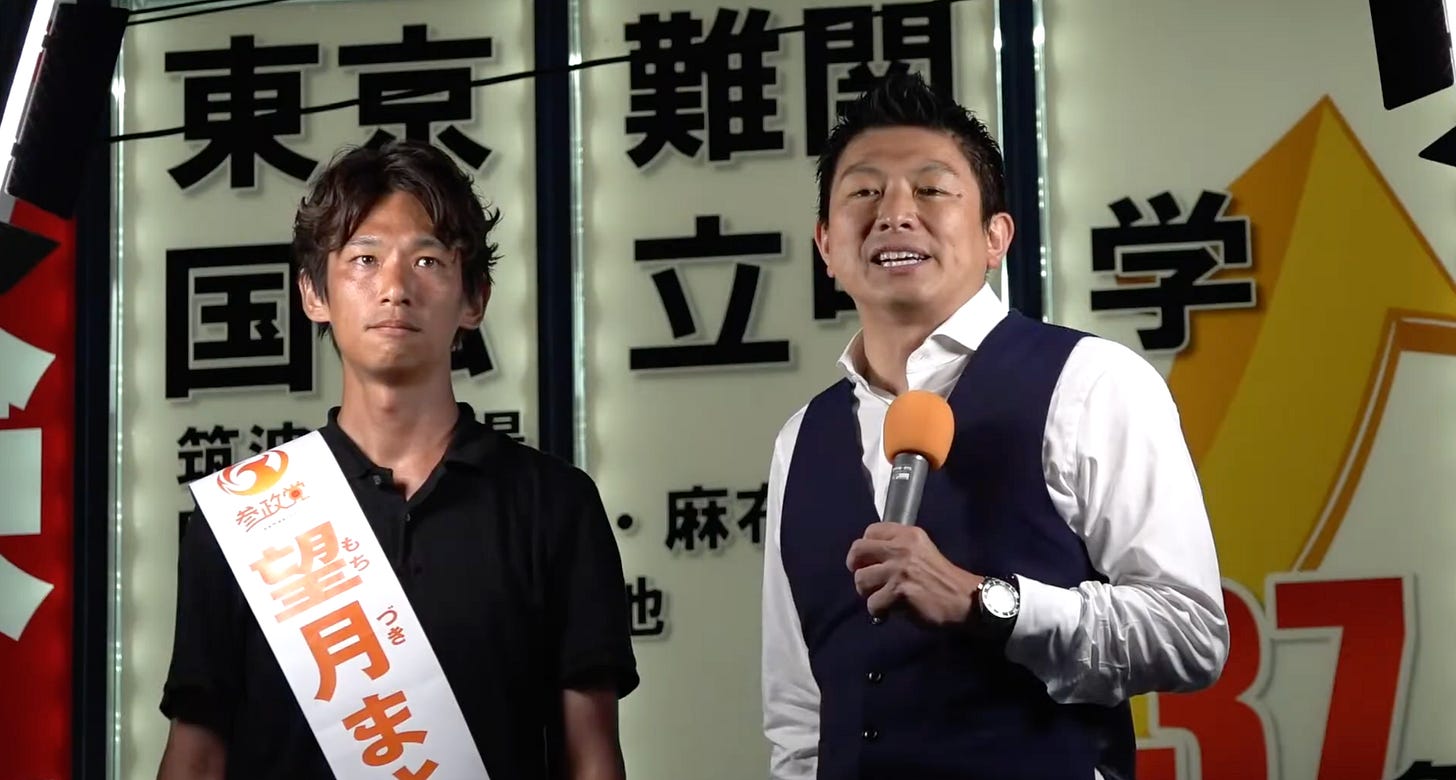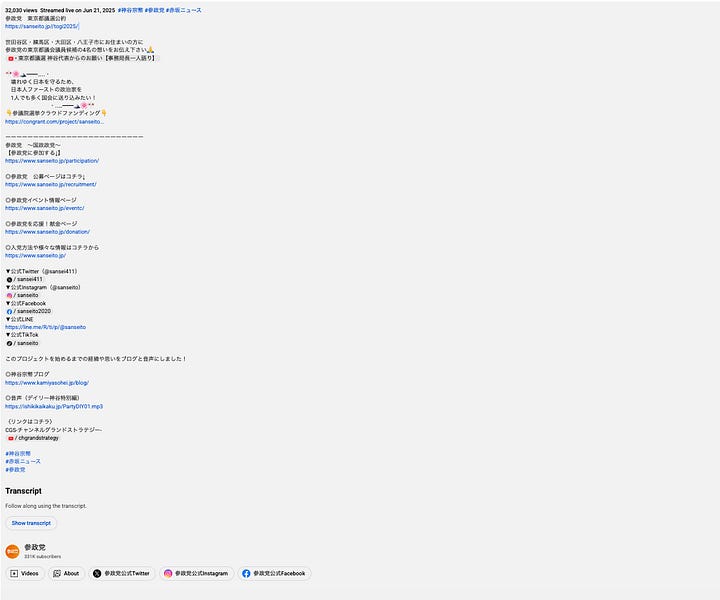Thank you for reading Observing Japan. This post is available to all readers.
If you are looking for timely, forward-looking analysis of the stories in Japans’s politics and policymaking that move markets, I have launched a new service through my business, Japan Foresight LLC. For more information about Japan Foresight’s services or for information on how to sign up for a trial or schedule a briefing, please visit our website or reach out to me.

While in absolute terms it remains a marginal player in Japan’s politics, following the Tokyo metropolitan assembly elections – in which three of its four candidates won seats and in which the party received 117,389 votes – it is increasingly difficult to ignore the presence of Sanseitō (referred to in English as the Do It Yourself party). The party is rising in opinion polls ahead of the upper house elections, and is planning on fielding candidates in each of the thirty-two single-member constituencies, constituencies that it is highly unlikely to win but fielding candidates in these races could a) help drive up the party’s results in proportional representation voting and b) could influence the outcome in close races depending on whether Sanseitō is able to draw voters away from more mainstream parties.
The party is both a policy innovator and an organizational innovator. While in some ways its program has a lot in common with other and earlier right-wing movements – its emphasis on national security, the defense of traditional values, and patriotic education1 – and overlaps with the LDP right and the center-right Democratic Party for the People (DPFP) in calling for expansionary fiscal policy, the party is more unabashed in its xenophobia (it refers to the “silent invasion” of immigrants into Japan) and, in its opposition to “totalitarian globalism” taps into what has been called “conspiracism,” a generalized view of the world that Thomas Milan Conda describes as “a mental framework, a belief system, a worldview that leads people to look for conspiracies, to anticipate them, to link them together into a grander overarching conspiracy.”2 The party’s program essentially stitches together conspiracism with more conventional policies and proposals, though, given the party’s origins in opposition to masking and vaccination during the Covid-19 pandemic, conspiracism is at the heart of the party’s identity.3
But this conspiracism may also have contributed to its organizational innovations. The party has organized itself as what Waseda political scientists Robert Fahey and Romeo Marcantuoni refer to as a “digital party.” Fahey and Marcantuoni describe how the party outraised more established parties by charging fees that entitle members to participate in party decision-making and receive access to party podcasts, newsletters, and lectures, as well as training programs for party organizers that have helped development the party’s electoral machinery.4 These information channels for insiders are complemented by the extensive use of YouTube and other social media to sidestep establishment media and communicate directly with the public. Nikkei found that ahead of the Tokyo assembly elections, Sanseitō was far and away the most-searched-for party in the race, effectively drawing voters into its information space. In other words, the party is serving up a hermetically sealed information space that strengthens its members’ links with the party.


Perhaps not surprisingly, Sanseitō has made particularly strong inroads with “unmoored” younger (and male) voters who likely have few if any attachments to established political parties and, as discussed here, are almost entirely disconnected from the media consumed by older Japanese.5 Among other things, this political “alternate universe” makes it difficult to assess, for example, what impact Sanseitō candidates might have on races in single-member constituencies, if the party’s voters are dedicated Sanseitō voters rather than independents who might otherwise vote for the mainstream ruling or opposition parties. That said, as Nikkei suggests, the party could be poised to peel off “hardcore” conservative voters who have been frustrated with the post-Abe Liberal Democratic Party (LDP).
Notwithstanding the party’s still-small presence in political institutions – it has one member of the upper house, three members of the lower house, seven prefectural assembly members, and 143 local assembly members – it is precisely this ability to appeal to draw in voters who have been poorly served by other parties that could make it more of a force over time. Unlike other outsider parties, Sanseitō’s leader Kamiya Sōhei has been patiently expanding the party’s footprint, stressing the party’s commitment to its participatory philosophy, and avoiding some of the boom-and-bust dynamics that have afflicted earlier new parties that relied more on charismatic leadership than on grassroots organization.6 If the party can continue building an electoral machine and peel off independents and supporters of more mainstream parties, it will force its way into more mainstream political discourse, attracting more coverage from the mainstream media, and more opportunities to attract new supporters.
In this sense, while the future of the Ishiba government is the single most important question in the upper house elections next month, the next most important question may be whether the election will be Sanseitō’s coming out party after five years of organization building – and what impact that will have on Japan’s politics as the age of fragmentation continues. The party’s goals are still modest, aiming for six seats in the upper house, but its impact could still reach far beyond its raw totals, not least in demonstrating the political consequences of the diverging information environments between older and younger voters.
During the Tokyo campaign it referred to reviving the late Ishihara Shintarō’s education policies, and party leader Kamiya Sōhei recently defended remarks about Okinawa made by right-wing LDP lawmaker Nishida Shōji.
There are also signs of the “New Age wellness-to-alt right” pipeline among Sanseitō’s supporters, as seen in the United States and other democracies.
They also note that the party provides English instruction to help members access American political discourse.
Perhaps this is another example of the Gen Z gender polarization seen in other democracies.
Though its fortunes are not entirely divorced from Kamiya’s activities, for, as Fahey and Marcantuoni note, a scandal involving the suicide of one of Kamiya’s secretaries who had been subject to “power harassment” may have led membership numbers to dip.




